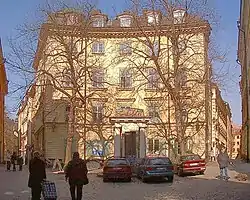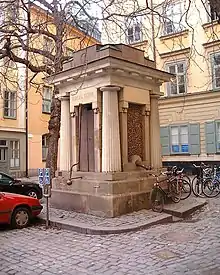Tyska Brunnsplan


Tyska Brunnsplan (Swedish: "German Well Square") is a small, triangular public square in Gamla stan, the old town in central Stockholm, Sweden. It is located in the junction between the streets Svartmangatan and Själagårdsgatan, the former leading to Stortorget and the latter to Brända Tomten. As several local names knows to tell (e.g. Tyska Stallplan and Tyska Skolgränd) the square is named after the vicinity to the German Church and the German community which once occupied the neighbourhood.
Origin of the name
The square appears as Tyske Brunnen ("German Well") and Stadsens brunn vid Gillestugan ("the city's well by the guild homestead") in 1649; as Tyska Brunn in both 1728 and 1820; and as Tyska Brunsplan in 1863.[1]
History
Until the early 18th century, the corner where the two streets meet was the location for a well of considerable proportions. During the later part of the century, the city's fire company established so called 'turning spaces' (spaces big enough for the turning radius of horse-drawn vehicles) at various locations to prevent throngs of people causing accidents in case of fire, and thus had a building demolished on this location in 1783 to create more space. They appointed the city architect Erik Palmstedt (1741-1803) to design the new square, its well and façades. The Neoclassical ambitions of the Gustavian architect had to be restricted in the Medieval urban landscape, which resulted in the present small-scale composition; the concave façade with its windows of various sizes acting as a scenic background for the magnificent well and its doric cast iron columns. The first synagogue in Stockholm (see Aaron Isaac) was found on the square's eastern side in the 19th century, from 1870 the location for a police station.[1][2]
The current location of the well flanked by two chestnut trees, was once the site of the pharmacy Svanen ("The Swan") which gave the block its Latin name Cygnus. With the creation of the square the pharmacy moved across Svartmangatan were its sign is still hanging.[3] The address is today the location for a public bath and the school of the old town.
See also
References
- "Innerstaden: Gamla stan". Stockholms gatunamn (2nd ed.). Stockholm: Kommittén för Stockholmsforskning. 1992. p. 79. ISBN 91-7031-042-4.
- Johan Mårtelius (1999). "Södra innerstaden". Guide till Stockholms arkitektur (2nd ed.). Stockholm: Arkitektur Förlag AB. p. 130. ISBN 91-86050-41-9.
- Béatrice Glase, Gösta Glase (1988). "Inre Stadsholmen". Gamla stan med Slottet och Riddarholmen (in Swedish) (3rd ed.). Stockholm: Bokförlaget Trevi. p. 63. ISBN 91-7160-823-0.